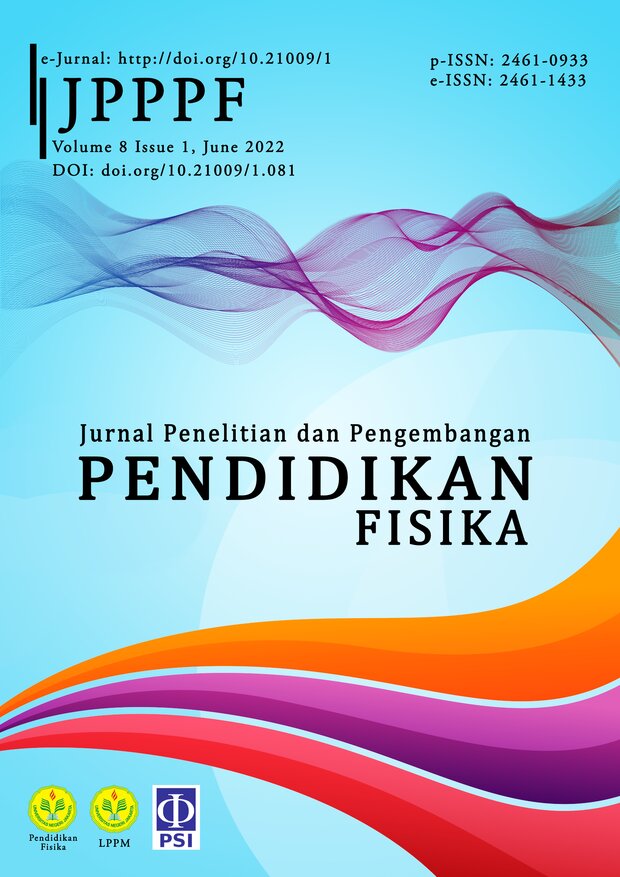Understanding the Newton’s Motion Concept Through Qualitative and Quantitative Teaching
DOI:
https://doi.org/10.21009/1.08113Keywords:
Newton’s motion concept, qualitative teaching, quantitative teachingAbstract
This research aims to analyze the influence of qualitative teaching and quantitative pursuit on understanding the concept of motion Newton Student of Science Education Study Program of FMIPA UNM. The main objectives of this study were to obtain information: 1) the characteristics of pretest and post-test results of understanding of Newton’s motion concepts of students following qualitative teaching, 2) characteristics of pretest and post-test results of understanding of Newton’s motion concepts of students following quantitative teaching, 3) student activities, and 4) a significant difference understanding of Newton’s motion concepts of students who follow qualitative teaching and who follow quantitative teaching. The research method used is mixed. The embedded experimental model, the population of 100 student’s odd semester of 2019/2020 divided into group A of 50 students and group B of as many as 50 students. The techniques used for data collection were interviews and tests, and the data were analyzed qualitatively and quantitatively. The results of the study were found in group A: 1) initial understanding of Newton’s concept based on Aristotelian’s theory of 30 students (60 percent), Impetus 15 students (30 percent), and Newton’s five students (10 percent). The post-test result of understanding Newton’s concept of motion is based on the theory of Aristotle for one student (2 percent), impetus’s theory for four students (8 percent), and Newton’s theory for 45 students (90 percent). In group B: 2) early understanding of Newton’s motion concept based on Aristotelian theory for 35 students (70 percent), Impetus theory for ten students (20 percent), and Newton’s theory for five students (10 percent). The post-test result of understanding Newton’s concept of motion based on the theory of Aristotle for five students (10 percent), Impetus theory for 35 students (70 percent), and Newton’s theory for ten students (20 percent); 3) student activity in following learning included in the high category, and 4) There is a significant difference understanding of Newton motion concept of students who follow qualitative teaching and who follow quantitative teaching. The study found that strict mathematical formulations do not foster the ability to comprehend the physical concept qualitatively. Students are generally only interested in solving physics problems that are manipulating numbers and equations. They are not passionate about the qualitative aspects of mathematical formulations.
References
Antonius., Poedjiastuti, H., & Hadin, M. (2009). Studi Kelayakan Struktur, Lingkungan dan Mekanikal Elektrikal Bangunan Publik di Semarang. Laporan Penelitian. Semarang: Universitas Islam Sultan Agung.
Darodjat dan Wahyudhiana. (2015). Model Evaluasi Program Pendidikan. Jurnal Rekayasa, XIV(1): 9.
Indriana, D. R. (2019). Upaya Mewujudkan Undang-Undang Bangunan Gedung Ditinjau Dari Aspek Keandalan
Bangunan Gedung. Jurnal Arsitektur Grid - Journal of Architecture and Built Environment, 1(1), 38–45.
Manlian, R. A., & Simanjuntak, B. (2013). Identifikasi Variabel Penting Keandalan Bangunan Gedung Di Kota Serang. Jurnal Ilmiah Media Engineering, 3(3), 185–193. https://ejournal.unsrat.ac.id/index.php/jime/article/view/4279/3808
Nugraha, R., & Iriana, R. T. (2015). Estimasi Biaya Pemeliharaan Bangunan Berdasarkan Pedoman Pemeliharaan Dan Perawatan Bangunan Gedung (Permen Nomor:24/PRT/M/2008) (Studi Kasus Gedung Perpustakaan Wilayah Soeman H.S Pekanbaru). Jurnal Online Mahasiswa Fakultas Teknik Universitas Riau, 2(2).
Peraturan Menteri Pekerjaan Umum Nomor : 24/PRT/M/2008 tentang Pedoman Pemeliharaan dan Perawatan Bangunan Gedung.
Rohmat, A. (2020). Analisis Kerusakan Struktur dan Arsitektur Pada Bangunan Gedung ( Studi Kasus : Gedung F Universitas Muhammadiyah Sukabumi ). Jurnal Student Teknik Sipil, 2(2), 134–140.
Subasno, Yohanes. (2018). Provus’s Discrepancy Evaluation Model Pada Pendidikan Inklusi. Artikel Ilmiah. STIP-IPI Malang, 3(2): 25-26.
Usman, K. & Winandi, R. (2009). Kajian Manajemen Pemeliharaan Gedung (Buliding Maintenance) di Universitas Lampung. Jurnal Rekayasa, 13(2): 158.











